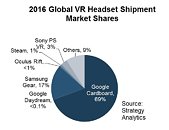Tuesday, February 21st 2017

Google Dominates VR Headsets Market: Strategy Analytics
2016 saw the launch of multiple new VR platforms vying for consumer, developer and enterprise attention. The Strategy Analytics report "VR Headset Platform Market Share Year End 2016" estimates that over 30 million VR headsets shipped, split between 6 major competing VR platforms in an increasingly fragmented landscape.
David MacQueen, Executive Director of Strategy Analytics' Virtual Reality Ecosystem research program, noted, "2016 certainly was a busy year in VR. Appearing alongside Google Cardboard were new platforms Google Daydream, Samsung Gear VR, Oculus Rift, PlayStation VR and SteamVR, currently served by the HTC Vive device, although more vendors will join this platform in 2017.""Our data shows that Google has a commanding lead in terms of shipments and installed base for its ultra-low cost Cardboard VR platform, and the size of the audience is already attracting marketers and brands looking to use VR as a promotional tool. However, it accounted for merely 12% revenue share. The higher-spec smartphone VR platform, Samsung Gear VR, took top spot by revenues with a 35% revenue share. Sony's successful PS VR launch sees that platform take second place by revenues, and between them Sony and Samsung captured more than half of VR hardware revenues in 2016".
Cliff Raskind, Senior Director at Strategy Analytics, added, "The successful push of VR hardware to consumers through direct sales, bundling and even giving devices away, is seeding the market and creating the audience required for successful ecosystems to grow. However, 6 competing ecosystems makes for a market which is crowded and fragmented. 2017 is sure to be an interesting year and we expect some shakedown as the competing ecosystems either cement their position or fall by the wayside. Hardware revenues or audience alone will not be enough to win, and we will continue to track the ecosystem evolution as new use cases, apps, and industries beyond gaming and media grow the market for VR and AR."
Strategy Analytics analysts will present our latest insights into the smart connected device ecosystem at MWC Barcelona.
David MacQueen, Executive Director of Strategy Analytics' Virtual Reality Ecosystem research program, noted, "2016 certainly was a busy year in VR. Appearing alongside Google Cardboard were new platforms Google Daydream, Samsung Gear VR, Oculus Rift, PlayStation VR and SteamVR, currently served by the HTC Vive device, although more vendors will join this platform in 2017.""Our data shows that Google has a commanding lead in terms of shipments and installed base for its ultra-low cost Cardboard VR platform, and the size of the audience is already attracting marketers and brands looking to use VR as a promotional tool. However, it accounted for merely 12% revenue share. The higher-spec smartphone VR platform, Samsung Gear VR, took top spot by revenues with a 35% revenue share. Sony's successful PS VR launch sees that platform take second place by revenues, and between them Sony and Samsung captured more than half of VR hardware revenues in 2016".
Cliff Raskind, Senior Director at Strategy Analytics, added, "The successful push of VR hardware to consumers through direct sales, bundling and even giving devices away, is seeding the market and creating the audience required for successful ecosystems to grow. However, 6 competing ecosystems makes for a market which is crowded and fragmented. 2017 is sure to be an interesting year and we expect some shakedown as the competing ecosystems either cement their position or fall by the wayside. Hardware revenues or audience alone will not be enough to win, and we will continue to track the ecosystem evolution as new use cases, apps, and industries beyond gaming and media grow the market for VR and AR."
Strategy Analytics analysts will present our latest insights into the smart connected device ecosystem at MWC Barcelona.

10 Comments on Google Dominates VR Headsets Market: Strategy Analytics
I bet the most of those sales for Google Cardboard came from those slick chinese plastic enclosures, rather than the actual "cardboard".
At one point I wanted to buy a 4K VR headset, but something in my gut told me not to.
Many moons have passed since I sold my DK1, and we still have no full-featured VR titles... What kind of gaming revolution is that?
Either way not interested in any of them until they sort all the bugs and performance issue's out or at least 1/2 the price or more.
$10 plastic enclosure is hundred times better, and works much better.
Where I'm from, You can buy 10 cups of coffee for 2.5 eur. As a coffee addict I can say, that google cardboard is not worth sacrificing 10 cups of coffee (even if I normally drink twice that in one day).
www.mcvuk.com/news/read/6-3m-vr-headsets-were-shipped-in-2016/0178470
I wonder how these data analytics companies get their data...
Samsung GearVR, in my opinion, is not a VR headset either - it is an overpriced smartphone accessory, slightly more advanced than most chinese plastic boxes (but even those are starting to feature built-in gyro, controls etc.).
The only active piece of electronics in it is a gyro/accelerometer, proximity sensor and touch controls for the housing + a microcontroller to rule them all. No display - not a VR headset.
Also, the only reason it made it to the top, is because Samsung gave away GearVR for free with their S7(and some).
Given that in 2016 at least 13mil units were sold, no wonder some 4.3mil headsets were claimed. I'm actually surprised it's not more...
Now we heard from Steam guys that there is only a handful of VR games that made it past 250k $.
Guess how it ends up.